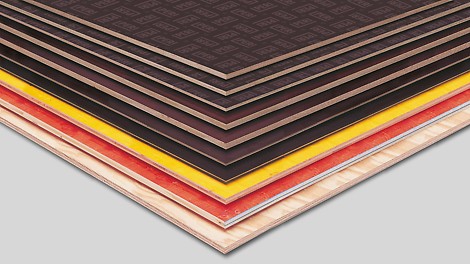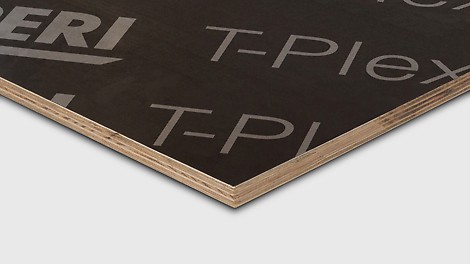
Before using the formwork panels and accessories at the construction site
- Use suitable fasteners to fix recess bodies and built-in parts in order to reduce damage to the formlining
- Avoid stepping on the formlining surface. Dirt on the soles of shoes can lead to scratches on the formlining and become visible on the concrete surface
- Reinforcement spacers should be used with large support. In this way, indentations in the formlining can be avoided under a given load.
- 1
![Zum Schutz vor Feuchtigkeit wird beschichtetes Sperrholz werkseitig an allen vier Kanten durch Kantenlack geschützt. Sie sollten diesen Schutz nach dem Sägen oder Bohren wieder herstellen.]()
![Seal edges and holes Zum Schutz vor Feuchtigkeit wird beschichtetes Sperrholz werkseitig an allen vier Kanten durch Kantenlack geschützt. Sie sollten diesen Schutz nach dem Sägen oder Bohren wieder herstellen.]()
Seal edges and holes
To protect against moisture, coated plywood is factory-protected on all four edges with edge varnish. You should restore this protection after sawing or drilling.
- Use sharp, suitable tools to work on the formwork panels.
- Seal unprotected edges and drill holes at least once with edge protection paint.
- 2
![Behandeln Sie die Schalungsplatten regelmäßig mit geeignetem Trennmittel. Das Trennmittel ist dünn und gleichmäßig aufzutragen und abzuziehen. Übermengen sind mit einem sauberen Tuch oder einem Wischmop zu entfernen. Beste Ergebnisse erzielen Sie mit qualitativ hochwertigen Betontrennmitteln wie PERI Clean, PERI Plasto Clean oder PERI Bio Clean.]()
![Oil before use Behandeln Sie die Schalungsplatten regelmäßig mit geeignetem Trennmittel. Das Trennmittel ist dünn und gleichmäßig aufzutragen und abzuziehen. Übermengen sind mit einem sauberen Tuch oder einem Wischmop zu entfernen. Beste Ergebnisse erzielen Sie mit qualitativ hochwertigen Betontrennmitteln wie PERI Clean, PERI Plasto Clean oder PERI Bio Clean.]()
Oil before use
Treat the formwork panels regularly with a suitable release agent. The release agent must be applied and removed thinly and evenly. Excess quantities should be removed with a clean cloth or mop. You can achieve the best results with high-quality concrete release agents such as PERI Clean, PERI Plasto Clean or PERI Bio Clean.
After formwork use
Tips for cleaning and protecting from the weather.
- 1
![Reinigen Sie die Schalungsplatten unmittelbar nach dem Ausschalen.
Nutzen Sie dazu nur geeignetes Reinigungswerkzeug um Beschädigungen zu vermeiden (keine Wasserhochdruckreinigung).
Reparieren Sie Kratzer oder Löcher mit PERI Reparaturplättchen.
Spachteln wird nicht empfohlen, da die Spachtelmasse nicht dauerhaft in der Schalungsplatte haftet.
Nach dem Schalungseinsatz ist auf eine sachgemäße Zwischenlagerung zu achten.]()
![Clean after use Reinigen Sie die Schalungsplatten unmittelbar nach dem Ausschalen.
Nutzen Sie dazu nur geeignetes Reinigungswerkzeug um Beschädigungen zu vermeiden (keine Wasserhochdruckreinigung).
Reparieren Sie Kratzer oder Löcher mit PERI Reparaturplättchen.
Spachteln wird nicht empfohlen, da die Spachtelmasse nicht dauerhaft in der Schalungsplatte haftet.
Nach dem Schalungseinsatz ist auf eine sachgemäße Zwischenlagerung zu achten.]()
Clean after use
- Clean the formwork panels immediately after removing the formwork.
- Only use suitable cleaning tools to avoid damage (no high-pressure water cleaning).
- Repair scratches or holes with PERI repair plates.
- Fillering is not recommended as the filler does not adhere permanently to the formwork panel.
- After using the formwork, care must be taken to ensure that it is stored properly.
- 2
![Schützen Sie die Schalungsplatten vor Kontakt mit Wasser und direktem Sonnenlicht.
Achten Sie auf gute Belüftung und Sauberkeit der Schalungsplatten.
Lagern Sie die Platten auf ebenem Untergrund, um Verbiegungen zu vermeiden.
Lagerung von sonstigen Baustoffen auf den Schalungsplatten, wie z.B. Bewehrungsstahl ist zu vermeiden.
Plattenstapel dürfen nur mit Umreifungsband gesichert transportiert werden.]()
![Protect from the effects of the weather Schützen Sie die Schalungsplatten vor Kontakt mit Wasser und direktem Sonnenlicht.
Achten Sie auf gute Belüftung und Sauberkeit der Schalungsplatten.
Lagern Sie die Platten auf ebenem Untergrund, um Verbiegungen zu vermeiden.
Lagerung von sonstigen Baustoffen auf den Schalungsplatten, wie z.B. Bewehrungsstahl ist zu vermeiden.
Plattenstapel dürfen nur mit Umreifungsband gesichert transportiert werden.]()
Protect from the effects of the weather
- Protect the formwork panels from contact with water and direct sunlight.
- Ensure good ventilation and cleanliness of the formwork panels.
- Store the panels on a level surface to avoid bending.
- Storage of other building materials on the formwork panels, such as reinforcing steel, should be avoided.
- Stacks of panels may only be transported secured with strapping.





